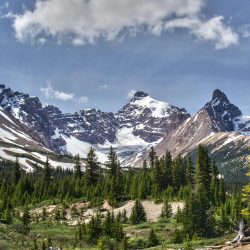Many international students end up loving Canada and want to stay after graduation. There is an opportunity for international students on a student visa to obtain Canadian Permanent Residency after graduation. Current students sometimes will wonder, “which province should I move to after graduation?”. Each province has different options for international students and offers different advantages and disadvantages.
Which Province is Easiest to Get Permanent Residency
There are 3 options for International Students to get Canada PR after graduation:
- Canadian Experience Class
- Federal Skilled Worker Class
- Provincial Nominee Program
The Canadian Experience Class and Federal Skilled Worker Class aren’t province-specific. If you’re interested in applying for Provincial Nominee Program then you will have to pick which province you want to apply for.
Below you’ll find each province in Canada and how immigrants explain their life in the province.
Alberta
Learn about Life in Alberta for Immigrants
Alberta Immigrant Nominee Program
British Columbia
Learn about Life in British Columbia for Immigrants
British Columbia Provincial Nominee Program
Manitoba
Learn about Life in Manitoba for Immigrants
Manitoba Provincial Nominee Program
Newfoundland and Labrador
Learn about Life in Newfoundland and Labrador for Immigrants
Newfoundland and Labrador Provincial Nominee Program
New Brunswick
Learn about Life in New Brunswick for Immigrants
New Brunswick Provincial Nominee Program
Nova Scotia
Learn about Life in Nova Scotia for Immigrant
Nova Scotia Provincial Nominee Program
Northwest Territories
Learn about Life in the Northwest Territories for Immigrant
Northwest Territories Nominee Program
Ontario
Learn about Life in Ontario for Immigrants
Ontario Immigrant Nominee Program
Prince Edward Island
Learn about Life in Prince Edward Island for Immigrants
Prince Edward Island Provincial Nominee Program
Saskatchewan
Learn about Life in Saskatchewan for Immigrants
Saskatchewan Immigrant Nominee Program
Yukon
Learn about Life in Yukon for Immigrants
How to Pick a Province for Canadian Permanent Residency After Graduation
When thinking about permanent residence in Canada for international students and graduates, please consider not only the province you graduated in but also the province you want to live and work in. Canada’s provinces are vast and offer so many different things for each person. There are several things that a student should look for in a province:
- Financial Earnings and Spending
- Weather Conditions
- Culture
Most Expensive Provinces in Canada to Live In
British Columbia
- The Economist ranked Vancouver as the most expensive city to live in North America, with the average price of a house a whopping $748,651!
- Victoria is the third most expensive city to buy a house in Canada, with an average price of $421,939.
Ontario
- Toronto is the second-most expensive city to buy a home in Canada (average price January 2013 $482,648).
- Canada’s fifth most expensive urban home center is Hamilton-Burlington (average home cost $349,943.) Located on the shore of Lake Ontario, if the traffic is cooperating, you’re less than an hour west of Toronto.
- Settling in Canada’s capital and fourth-largest city, Ottawa will cost the average new home buyer $343,382.
Alberta
- If you tried to buy a home in Calgary, a.k.a. Canada’s Energy Capital, the average cost would probably be around $418,983.
- Owning a new home in Edmonton will cost you on average $323,541.
- The Canadian Mortgage and Housing Corporation projected the average 2011 household income in the Fort McMurray region to be over $177,000 a year.
Saskatchewan
- A new home will set you back an average of $320,812 in Saskatoon.
Quebec
- A home in Montreal will set you back an average of $318,982, but the bonus is the city’s festive spirit!
Highest Unemployment Rate in Canadian Provinces
The list of Canadian provinces by unemployment rate are statistics that directly refer to the nation’s seasonally adjusted unemployment rate. The list will go from the province with the highest rate of unemployment to the least unemployment:
Nunavut: 14.1%
Newfoundland and Labrador: 12.4%
Prince Edward Island: 9%
Northwest Territories: 7.3%
New Brunswick: 7.2%
Alberta: 6.7%
Nova Scotia: 6.5%
Saskatchewan: 5.3%
Ontario: 5.2%
Quebec: 5%
British Columbia: 4.3%
Yukon: 2.7%
Now, even if a province you’re interested in has a higher unemployment rate, don’t rule it out! Many provinces have a high unemployment rate but have jobs available. Provinces such as New Brunswick and Nova Scotia are planning to accept more immigrants every year to fill these job positions.
Are You Interested in Canada Permanent Residency?
If so, Contact VisaPlace today. All our cases are handled by competent and experienced immigration professionals who are affiliated with VisaPlace. These professionals consist of lawyers, licensed paralegals, and consultants who work for VisaPlace Legal an award-winning immigration firm that adheres to the highest standards of client service.
Ready for the next step? Book your 1 on 1 consultation now or call us at 1-877-296-0874.
Have a Question related to your Immigration Needs?
Click here to fill out the FREE Immigration Assessment form below and get a response within 24 hours to see if you’re eligible.
The assessment form should take approximately 5-7 minutes to complete. We will get back to you within one business day to let you know if we are able to help.





